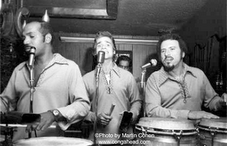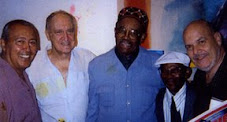 At East Harlem's Julia de Burgos Cultural Center, I attended Carmen and Rafi’s wedding recently. La musica got me up to dance with two girls as I had seen rumberos do at the
At East Harlem's Julia de Burgos Cultural Center, I attended Carmen and Rafi’s wedding recently. La musica got me up to dance with two girls as I had seen rumberos do at the The same thing happened at
What is this “dancer” doing in a list of thirty-five musicians that included Dave Valentin, Cachao and Rene Lopez, all legendarios? Especially since all he could manage to play were maracas and the campana? It was at the Smithsonian Institute’s Museum of American History that I was honored to lecture to a small audience on my donation of posters, and then a bit about the very early days of la musica: the Cabarojeño Club in the Bronx in 1937, the Teatro Cervantes, the ’39 Cuban Village at the World’s Fair, the Café Latino in Greenwich Village in 1937 with Jose Mangual Sr., the Miami Beach dance studio and La Conga craze across the nation in 1940, the La Playa dancers at the Wonder Bar in Detroit in 1938, Tony and Lucille Colon’s studio at Grossinger’s, and talk about Anselmo Sacassas, Julio Andino, Electrico, Rene and Estela, the Havana Madrid. Everything I mentioned there involved bands, conjuntos, grupos or espantaneos. Musicians.
When we paint the picture of los veteranos de la musica
What’s a six-foot Italian-American Brooklynite who didn’t speak la idioma doing playing “Bruca Manigua” on a harmonica for the audience at the Teatro Cervantes in 1937? What is he doing in the company of the greatest musicos, allowed into their dressing rooms, back stage and in their homes, invited to bautizos, weddings, birthdays like Louis Mangual’s 54th in
Never was I made to feel unwelcome, out of place or intruding. On the contrary, the abrazo fuerte bien puertoriqueño was the greeting, like two hermanos de leche. It’s more than hospitality, good manners and friendship—it is the affection, the gran afecto, that one feels like a mano, like the looseness I felt while singing a duet (“Tu no comprendes,” a song our long-gone friend Doroteo Santiago recorded in ’38) with Leo Fleming Jr. in my kitchen. How come he could greet you with “Ecobio monina boncó,” an amigo de pecho, could do a tornillo and ate chicharones de
How come he knew the lyrics to “Ofelia tenia un platito,” “Niebla del riachuelo,” “Vereda tropical,” “Pare cochero,” “Negro de sociedad,” “Un poquito de tu amor,” “Fufuñando,” “Santa Barbara bendita,” “La ultima noche” and “Timba timbero”? How did he find himself dancing along with Los Dandy’s de Belén? He was even digging Candido at El Kursal in La Vieja Habana in 1940, and in Maestro Lecuona’s dressing room at the Teatro Payret, opposite Sloppy Joe’s. He danced to Trio Caney on the patio of the Beachcomber, hung out with Louie Varona and “Jack, Jack, Jack” Bolivar at the El San Juan Hotel. He stayed at the Normandi Hotel, swam in El Convento’s small pool and had a shoeshine at the corner of Calle Luna.
Uneraseable reflections…stories behind the music that will be with him, not in la blanda cama, but while dancing with his nurse to “Chacumbele, el muerto se fué de rumba.”


No comments:
Post a Comment